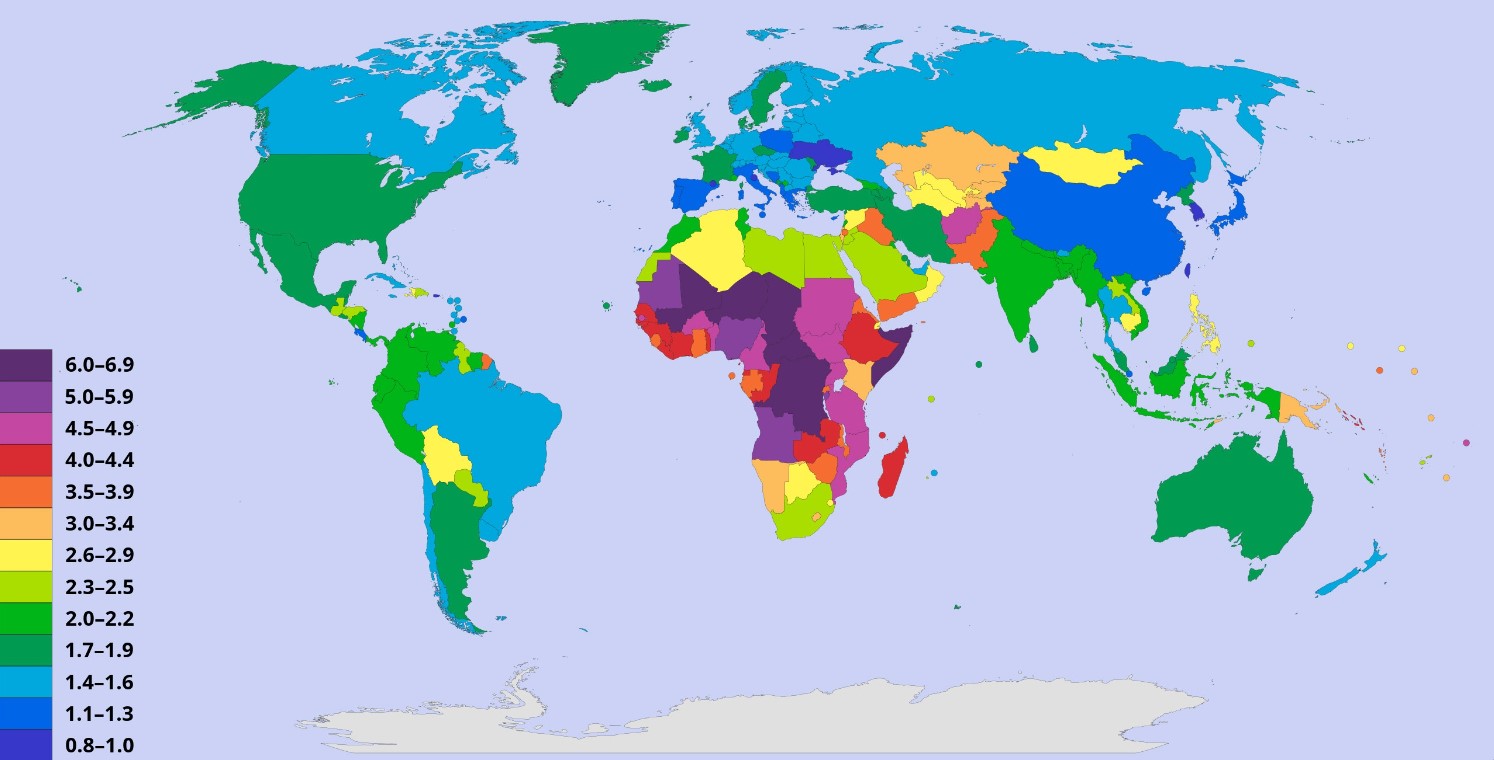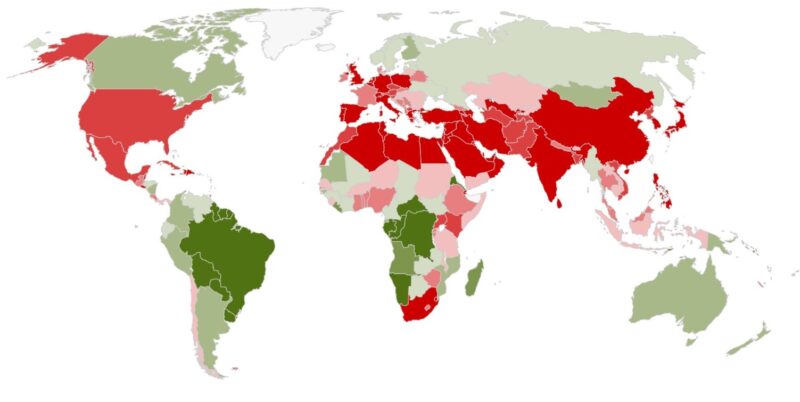 Fertility, the number of children per woman, determines the long-term trend. The author believes that the explosion in Africa must be unconditionally contained by an impenetrable wall so that mass migration of black Africans does not in the long run flood and displace all other peoples. Source: Total Fertility Rate Map by Country 2020, Korakys, Wikipedia
Fertility, the number of children per woman, determines the long-term trend. The author believes that the explosion in Africa must be unconditionally contained by an impenetrable wall so that mass migration of black Africans does not in the long run flood and displace all other peoples. Source: Total Fertility Rate Map by Country 2020, Korakys, Wikipedia
Uneven global population growth reaches 8 billion
According to the United Nations Population Fund (UNFPA), we celebrated the 8 billionth day* on November 15. The planet's population is still increasing dramatically, albeit at a decreasing pace.
Published: December 12, 2022, 6:55 am
Among Westerners and Japanese, however, the increase in population has been replaced by a decrease in population – we are thus becoming an ever-smaller minority on the planet. For Europe and the US, we are not only getting fewer, our place is being taken over by the population surplus from mainly Africa.
For utilitarians**, the 8 billionth day is a day of celebration:
“A milestone to celebrate diversity and progress while reflecting on humanity’s shared responsibility for the planet,” said António Guterres, UN Secretary-General.
“8 billion strong – a world of endless possibilities”, is a slogan for UNFPA’s #8billionstrong campaign.
You have to see everything positively, right? At the same time, everyone knows that there is a worrying amount of people, and that it eats away enormously at the earth’s life-sustaining biological system. Just producing the necessary foodstuffs requires massive inputs of fossil energy (diesel) and fertilizers (nitrogen, phosphorus, potassium). Plant breeding and, more recently, purposeful genetic modification (GMO) have also had their importance in that the yield has increased without the cultivated area being able to increase at the same rate.
In 2011 we reached 7 billion, that’s only 11 years ago.
In 1999, 6 billion was passed.
In 1987 we were 5 billion.

Immigration means that unborn Swedish children are replaced by migrants and their children. Advertising portrays the destruction as a modern “open-minded” lifestyle. Source: Zmarta
In 1950 we were 2.6 billion, the growth rate was over 2 percent per year and those who had the overview began to understand that it could not end well if it was allowed to continue.
In 1972, at the UN’s first environmental summit, the population issue was at the top of the agenda. The warnings of what the population explosion could lead to were common knowledge. In China and India, harsh population programs were started in the 1970s. The Chinese one-child program can be considered quite successful, but at the price of a lot of cruelty. The Indian programs failed because people perceived it as attempted genocide and revolted.
At the same time, population growth had already slowed down spontaneously in Western Europe and somewhat later in Japan and the United States, in the latter case at least among European descendants. Why?
The population issue has become taboo
The panic that many felt in the 1960s and 70s over the “population explosion” has subsided. The acute disaster risks were averted by the industrialization of food production, the “green revolution”, i.e. mechanization, plant breeding and massive fertilization.
Leftists in association with neoliberals shut down the population issue and made it politically incorrect to even talk about. The red-green argued that it is the amount of rich “white men”, not “poor women”, that is the real overpopulation problem. Neoliberal capitalists (“white men”), on the other hand, promised that the market could drive technological solutions to all scarcity problems. We shall not talk about the religious ones. They meant that the more people, the more ingenious technical solutions we get. “Imagine if Beethoven’s mother had contraceptives! How many great opportunities are not lost because of abortion and birth control?” As if people conjured natural resources out of a hat.
Free women opt out of children
Today, it is pretty much agreed that coercion is a difficult method to reduce the number of children. In contrast, reduced birth rates seem to come naturally with women’s education, emancipation and freedom, of course supported by access to contraception and abortion. Free women who feel equal in all respects to men often choose not to have children and family. Health care, nutrition and vaccines that enable children to survive also reduce the financial and emotional demands of having many children.
These contexts have been understood in many parts of the world. Even relatively poor countries like India have seen more pervasive fertility reduction through education than ever achieved through coercion and fraud. This must be understood as hopeful.
The population issue has become the migration issue
Slowly, the population issue has risen to the surface again, but now the issue is completely different than in the 1970s.
The nativity has plummeted in large parts of the world. Europe, Japan and Russia have a population decrease of the indigenous population – it is only immigration that causes Sweden and some other countries to increase their population.
In China, Iran, Pakistan, India, Indonesia and South America, the birth rate is often close to or below the stability level, but the population is still young and continues to grow because a large number of women from the last great litters are now having two children***. The population is also growing due to increasing life expectancy.
It is from Africa that the threat comes.
Africa is exploding
In Africa south of the Sahara, the population explosion is going on essentially unchecked. Despite health care, despite schools and despite contraceptives, people choose to have children as before. The continent today has around 1.3 billion people, in 1913 the whole of Africa was estimated to have around 125 million. If development follows current trends, Africa would quadruple its population from today to 2100.

Ecological footprint. Here is an attempt to illustrate the ecological pressure of human activity by nation. The calculations behind it can certainly be debated, but the result still gives an indication of where it is leaning. In temperate and subtropical regions are the countries that have overexploited their natural conditions (red on the map). Densely populated or not, they can be said to be overpopulated. The green countries on the map still have more biological vitality to give than the people there consume. Note that it is not necessarily rich countries that overexploit, or that poor people would be innocent. It is population multiplied by the citizens’ ecological requirements that is decisive. Low population with high material requirements can be sustainable, as well as a large population that lives very spartanly. Map: data.footprintnetwork.org
Nigeria is the heir to the Benin Kingdom, black Africa’s most famous high culture. The developments in Nigeria should terrify every European. In 1963 there were 55 million people in Nigeria, the growth rate was then about 5 percent per year. Today, around 225 million are counted. The birth rate has actually fallen, but is still high, 4.6 children per woman. Today, growth is around 2.5 percent per year. At the current rate, it is estimated that Nigeria alone could grow to one billion people before the year 2100! Few believe it will happen, but what will stop it? War and famine? Migration to Europe? Or that Nigerian girls acquire European expectations about children and family?
Tanzania’s population pyramid shows aggressive exponential growth while Italy’s population pyramid provides a dramatic example of a people who have lost the will to live. When the last large generations, born in the 1960s and 70s, disappear, the population will be more than halved.
Tanzania has been an important recipient of Swedish aid. In the 1950s we had roughly the same population, 7 million. Today, Tanzania has 62 million inhabitants. Since 1962, Sweden’s aid has been in round numbers one billion kroner per year, or 66 billion over 60 years (2013). The aid seems to have had a very modest effect. The country’s growth is being eaten up by population growth.
Somalia is the heartland of Swedish “refugee” immigration in Africa. Somalia’s population has increased from 2.3 million in 1950 to an estimated 17 million in 2022. Fertility: 5.3 children per woman. The growth rate 3.2 percent per year, which doubles every 21 years!
Africans may have a human right to make their own reproductive choices, but then they are also obliged to take care of their offspring. It is not our responsibility. We Europeans must steel ourselves. If Europe is to survive, the door to immigration from Africa must be closed completely. Anything else would be demographic suicide.
Asia, Middle East, North Africa, South America
In much of the world, including the most densely populated parts of Asia, birth rates have fallen sharply over the past twenty years. Many countries have a young population that is still growing due to demographic inertia (people are living longer), but the long-term forecast is stability and slow decline if Europe continues. We shouldn’t have any immigration from the Middle East or Asia either, but that’s more because they are already so heavily populated.
Europe, Japan and North America
Currently, Europe and Japan have very weak fertility. Birth rates that go below 1.5 down to 1.3 indicate that the population has lost the will to live. And then you have to expect that it is actually even worse, as some immigrant groups greatly increase the statistics for birth rates.
It may have to be met with pronatalist policies such as in Hungary, where women are rewarded with tax exemptions if they have four children. Declining populations is not a problem in principle because we live on an over-exploited planet, but it is a very serious matter to try to keep growth going through immigration from expanding regions. It’s suicide!
Between 2007 and 2021, in just 15 years, 1,707,364 people have immigrated to Sweden. These make up over 16 percent of Sweden’s population. It’s fast! At the same time, the number of 1,707,364 represents approximately 5 percent of Africa’s population growth in a single year. In 15 years, Sweden has therefore received a number corresponding to approximately 18 days of population growth in Africa.
Will it have any noticeable effect on Africa’s overpopulation problem? No.
Our peoples, ethnicities and cultures must fight to survive and define our continent. That can only happen if we put an absolute end to all types of non-European immigration.
As Hungary’s Prime Minister Viktor Orbán has said: “We don’t just look at numbers, we want Hungarian children. Migration is for us to give up.”
—
* This is of course a rough estimate. Few countries have such a rigorous population count as Sweden and even here we don’t know when there are more than ten or twenty thousand how many there are (how many illegal immigrants and double identities are there?).
** Utilitarianism: The greatest possible happiness for the greatest possible number. Since happiness is difficult to measure, but numbers are all the easier, in practice it becomes: Largest possible number. This is called “the repugnant conclusion” and, in my opinion and that of many other thinkers, disqualifies utilitarianism as a moral guideline. The false premise is that only human life has value and that this value is always positive.
*** This is called population momentum, demographic inertia.
Comment:
Whether one believes that climate change is a matter of fate or not, there is no doubt that humanity has put the planet’s life support systems under severe pressure. Looting, poisoning, wilderness destruction and extinction are strongly related to the number of people, their lifestyles and technologies.
Population growth is thus still high, but the long-term trend is that the aggressive “population explosion” has stopped, the increase is slowing down and is expected to reverse, according to UN demographers, until we achieve stability or a slow population decline at the end of the century. However, it does not happen by itself.
The technologists always have a technical solution
There are those, especially among religious but also among radical nationalists, who believe that the globalist elite is secretly carrying out an evil plan to drastically reduce the earth’s population. Investments in “sexual and reproductive health”, contraception and abortion, as well as sometimes vaccination programs are interpreted as planned genocide. I don’t think so at all.
The globalists, for example the World Economic Forum, are quite explicit. They are so sure of their cause that they don’t exactly hide their intentions (for those who want to read more than the headlines). Their megalomaniacal vision, Agenda 21 (with sub-plan Agenda 2030), is a plan to solve all of humanity’s problems. But two major problem areas are missing, of which the population issue is one.
The other issue that is not dealt with in the Agendas is how people’s free life choices and personal integrity can be preserved. It’s not that weird. It is precisely freedom and privacy that must be sacrificed on the altar of technology. The “solution” is, by implication according to the WEF, to let the Machine take over.
Of course, everyone knows that population affects everything and that population is one of the most important factors that complicates all attempts to find a long-term sustainable economic-ecological balance, but it is not politically correct to talk about it.
F = W x H x D
Humanity’s total impact, its ecological “footprint”, (F) is the product of population (P), consumption per person (K), modified by a technology factor (T). If F is to decrease from the current excessively high level, P or K must decrease or the technology to extract resources must be refined (so that T decreases). Preferably all three factors, but if two are held, it gives three different basic strategies:
1) WEF has the backing of all the biggest technology companies. They mean that if we let scientists and engineers free and equipped with artificial intelligences, T will go towards zero, that is, we can be as many as we want and get everything we point to without a single wilderness needing to be exploited. Fusion power is the holy grail.
2) Many of the so-called “greens” are in the technology-enthusiastic WEF group, but more radical “greens” (for example, Extinction Rebellion) want to specifically attack the consumption of the common man. If everyone settles for mini-consumption, veganism or an insect diet and virtual experiences, we can even become many more and at the same time save the biosphere, they say.
3) Finally, you can go to the core of the (P)udel. If only we could become significantly fewer, we could have a more relaxed relationship with both technology and consumption. The problem is that it would take a long time to significantly reduce P if you are to stay within the humanitarian acceptable. If the birth rates in Western Europe applied globally, it would take at least 500 years to reduce the world population to 500 million, in the meantime one would have to rely on reducing K and T according to the first or second track.
A fourth “solution” is to follow the short-term economic wishes of people, governments and companies, “business as usual”, until we create such an ecological mega-chaos that it destroys most of nature and kills a large part of humanity. Unfortunately, most things speak for that development. From the ashes, the survivors can perhaps rise a little wiser and more careful.
All rights reserved. You have permission to quote freely from the articles provided that the source (www.freewestmedia.com) is given. Photos may not be used without our consent.
Consider donating to support our work
Help us to produce more articles like this. FreeWestMedia is depending on donations from our readers to keep going. With your help, we expose the mainstream fake news agenda.
Keep your language polite. Readers from many different countries visit and contribute to Free West Media and we must therefore obey the rules in, for example, Germany. Illegal content will be deleted.
If you have been approved to post comments without preview from FWM, you are responsible for violations of any law. This means that FWM may be forced to cooperate with authorities in a possible crime investigation.
If your comments are subject to preview by FWM, please be patient. We continually review comments but depending on the time of day it can take up to several hours before your comment is reviewed.
We reserve the right to delete comments that are offensive, contain slander or foul language, or are irrelevant to the discussion.

South Africa’s infrastructure 30 years after the end of Apartheid
LondonHating South Africa was part of growing up in North London in the 1980s. Pelle Taylor and Patrick Remington from Two Raven Films, recently interviewed South Africans about the decline of the country after Apartheid ended.

Nigerian President: More weapons for Ukraine end up in Africa
LagosSome time ago, FWM reported on arms deliveries to Ukraine, which shortly afterwards were resold on the Internet. Nigerian President Muhammadu Buhari has warned that "weapons used in the war in Ukraine are gradually leaking into the region" and called for strengthened border security.

Namibia sees opportunity to attract German energy refugees
Windhoek"The former German colony, Namibia wants to help Germany in its energy crisis". This is how an article in the online edition of a German newspaper recently began about Namibia's new "Digital Nomad" visa. The six-month visa is ideal for long-term holidaymakers. And for professionals who have their office on their laptop and can work from anywhere.

French fuel debacle spills over to Senegal
DakarThe recent events at the French embassy in Burkina Faso were yet another demonstration against France on the African continent after France was ousted from Mali. All it took was a rumour to attract the sympathy of the population and demonstrators to head to the French Embassy.

New South African drone to compete with Turkey’s Bayraktar
PretoriaThe South African defense company Milkor unveiled its Milkor 380 reconnaissance and attack unmanned aerial vehicle (UAV). It is expected to become a competitor to Turkey's Bayraktar and Anka drones.

Bucking the trend: Uganda bans work by LGBT group
KampalaThe Ugandan government has banned the activities of a local non-governmental organization that campaigns for the rights of sexual minorities. According to a senior official, the organization worked illegally in the African country.

South Africa: 82 suspects arrested after a mass rape
KrugersdorpDozens of black men ambushed a film crew at an abandoned mine near Johannesburg on Friday. They raped eight models between the ages of 19 and 35. As they fled, the police shot dead two suspects and 82 other people were arrested.

BRICS expansion on the cards
More and more emerging countries are considering joining the BRICS group, which is seen as the major emerging countries' counterweight to the US-led West and the G7. Especially in times like these, this is also a clear signal to Washington.

Poland opens border after South Africa complains about their treatment of blacks
PretoriaThere is a very diverse crowd on the German-Polish border currently trying to take advantage of the war situation. Do they really all come from Ukraine?

Cameroon celebrates herbal medicine miracle against Covid-19
JaundeThe western African country of Cameroon is one of the nations with the fewest victims in the pandemic: Only 100 000 infected and 1 600 deaths were counted among its 27 million inhabitants. That means that the incidence rate is 50 times lower than in European countries.
